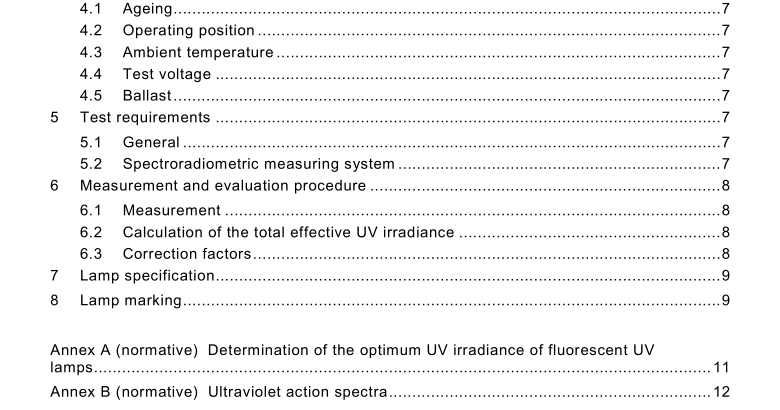IEC 61228:2008 pdf download – Fluorescent ultraviolet lamps used for tanning – Measurement and specification method
4.1 Ageing
Before the initial measurements,lamps shall be aged for a period of 5 h±0,25 h undernormal operating conditions.
4.2Operating position
During ageing and measurement, lamps shall be operated in a horizontal position.Ageing ispreferably in a horizontal position; a vertical position may also be applied.
4.3Ambient temperature
The measurement shall be made in a draught-free atmosphere at an ambient temperature of25°C±1°c.
NOTE lf applicable,lamps may also be measured under conditions different from the above standard ambienttemperature conditions to establish the optimum UV irradiance,as described in AnnexA.
4.4Test voltage
The test voltage applied to the circuit shall be as specified on the relevant lamp data sheet.
4.5Ballast
Lamps shall be operated with a reference ballast. In cases where a reference ballast has notbeen established,an appropriate test ballast shall be specified by the lamp manufacturer orresponsible vendor. The ballast shall be operating at a frequency of 50 – 60 Hz.
5Test requirements
5.1General
Spectroradiometric measurements shall be made in accordance with the relevantrecommendations of the CIE (International commission on illumination ), as given in CIE 63.
Additional information about UV measurements is given in Annex B of IEC 62471.
Requirements for electrical measurements are given in Annex B of lEC 60081 and lEC 60901.5.2Spectroradiometric measuring system
Lamps shall be measured in an appropriate spectroradiometric system to obtain the spectralirradiance.
The system input optics shall have cosine response to accurately measure irradiance.The spectroradiometer shall have a bandwidth not exceeding 2,5 nm.
The distance between detector and lamp axis is not specified but shall be not less than 10 cm.
NOTE 1 For the publication of the final lamp specifications, the measured irradiance values are corrected toarrive at irradiance ‘values at 25 cm distance from the lamp axis (see 6.3).
NOTE 2 A bandwidth of 1 nm is advisable for greater measurement accuracy in cases where a rapid change ofthe spectral irradiance occurs within a small bandwidth area.
6 Measurement and evaluation procedure
6.1 Measurement
The spectral irradiance shall be measured at intervals of 1 nm from 250 nm to 400 nm. Under the test conditions, the lamp power, current and voltage shall be recorded.
6.2 Calculation of the total effective UV irradiance
The total effective UV irradiance shall be calculated from the spectral irradiance using the following formula:
where
E eff is the total effective irradiance (W/m 2 );
E λ is the spectral irradiance (W/(m 2 .nm));
S( λ ) is the weighting factor according to the applicable action spectrum;
Δ λ is the wavelength interval (nm).
The wavelength interval for the calculation shall preferably be equal to the bandwidth.
The applicable action spectra for erythema and NMSC are given in Annex B.
For the total effective UV irradiance weighted according to the erythema action spectrum, the summation shall be performed over the following wavelength range:
250 nm ≤ λ ≤ 400 nm.
For the total effective UV irradiance weighted according to the NMSC action spectrum, the summation shall be performed over two wavelength ranges:
250 nm ≤ λ ≤ 320 nm, and
320 nm < λ ≤ 400 nm.
NOTE The limit of 320 nm is chosen in accordance with IEC 60335-2-27, where for this application the CIE nomenclature UV-A and UV-B with a limit of 31 5 nm is not used.
6.3 Correction factors In order to arrive at the final total effective UV irradiance values, the following two correction factors may have to be applied:
a) for lamps having the optimum UV irradiance at an ambient temperature other than 25 °C, a factor to obtain the optimum UV irradiance, as described in Annex A;
b) for lamps measured at a distance other than 25 cm, a factor to obtain the UV irradiance at 25 cm distance. This geometrical factor can be obtained for each lamp type either experimentally or by calculation.
7 Lamp specification
The following information shall be given for each lamp type in the manufacturers literature:
a) lamp dimensions;
b) for reflector lamps, the reflector angle α , i.e. the angle subtended at the lamp axis by the reflector coating;
